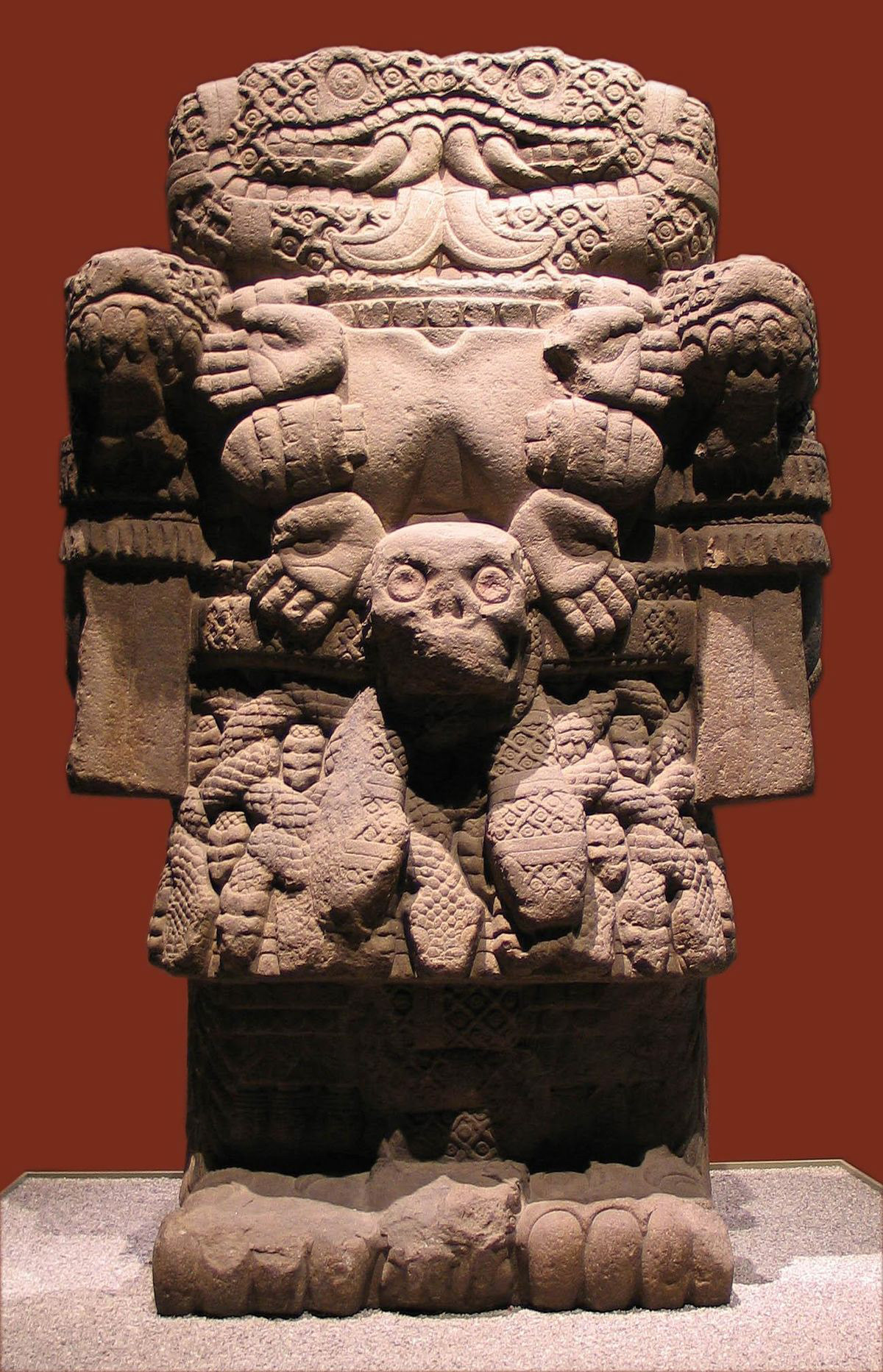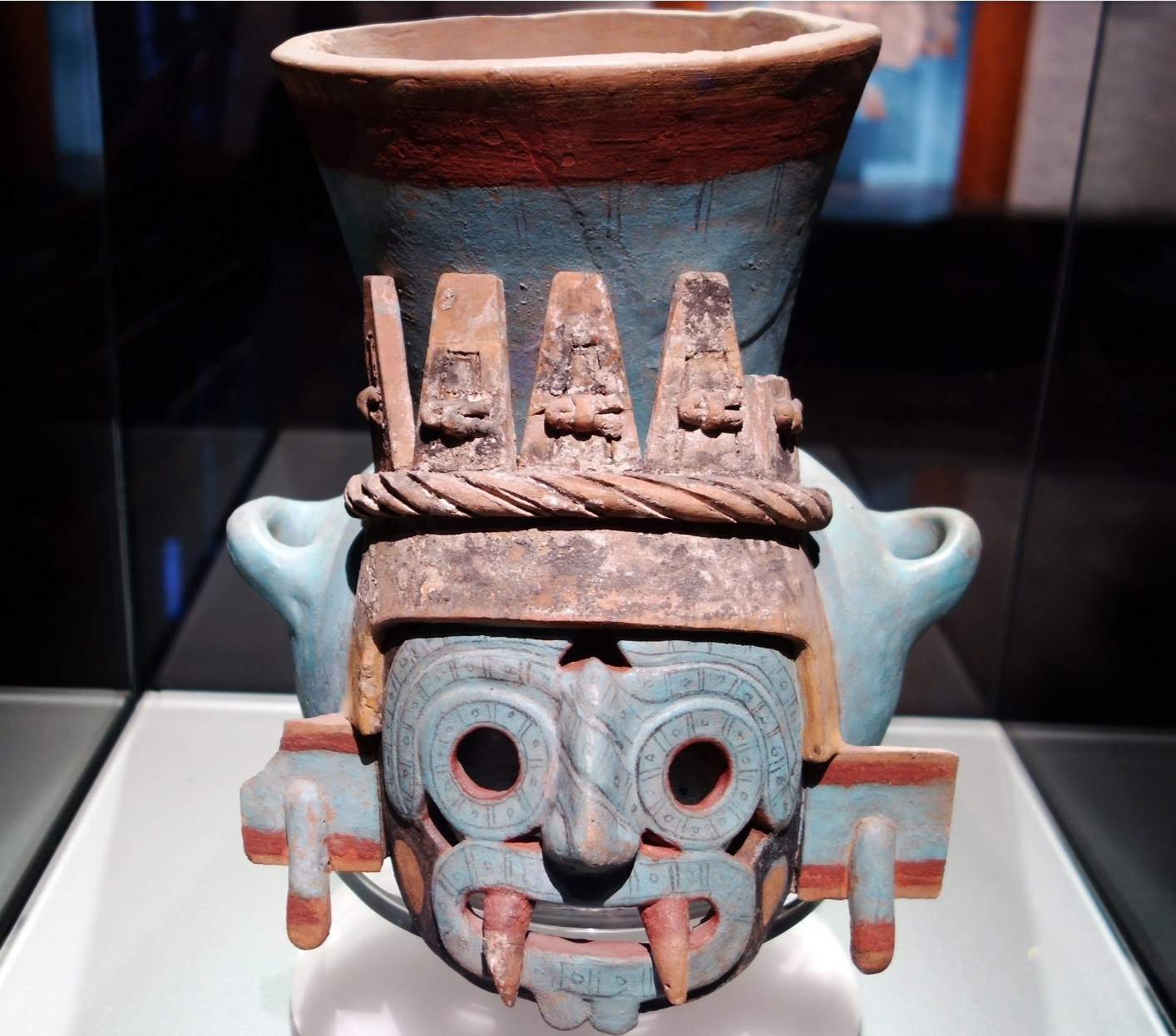
Aztec, Coatlicue, c. 1500, basalt

Aztec, Brazier of Chicomecóatl, c. 1500, clay

Aztec, Tlaloc Vessel, c. 1440-70, clay
The new exhibition, Aztec Depictions of Divine Deities, will feature three marvelous sculptures. Coatlicue, Brazier of Chicomecóatl, and Tlaloc Vessel will be on display at El Museo Nacional de Antropologia. What these three sculptures have in common is that they are each a representation of a highly respected and feared god or goddess in the Aztec religion. Religion was incredibly important to this group of people. The idea of gods for Aztecs, teotl in Nahuatl, was different than European ideas of god. For the Aztec, the gods were more so natural forces than spiritual beings. They would capture a god’s physical features in stone, clay, or any other kind of medium, and the power and force of the deity was kept in a sacred bundle stashed away secretly in a temple.
The first figure to be presented is Coatlicue, a nine-foot-tall statue carved from a basalt boulder. She was one of the most important and sacred deities in the Aztec civilization. The Goddess was known to be loving and nurturing as well as fearsome and unforgiving. She was both a creator and a destroyer. She is known by many names: The Aztec Mother Goddess, Lady Snaky Skirt, and of course, Coatlicue, to name a few. She is the mother of Coyolxuahqui, Huitzilopochtli, and the Centzon Huitznahuas, which were four hundred brothers that later became the stars. It is said that one day Coatlicue was atop a hill known as Coatepec or Snake Mountain. As she swept the temple clean, feathers floated down to her and she placed them between her breasts. At that moment she miraculously became pregnant with Huitzilopochtli, the deity of war and hunting. When Coyolxuahqui and her brothers received word of their mother’s condition, they decided they would kill her and the unborn child. As they neared Coatepec, Huitzilopochtli sprang out from his mother’s womb as an adult clad in warrior armor and wielding weapons. He proceeded to protect his mother by killing all four hundred of his brothers. He also beheaded Coyolxuahqui and threw her body down Snake Mountain which became dismembered as it reached the bottom. After rising victorious, it is said that Huitzilopochtli flung the bodies of his siblings into the sky and created the stars and the moon.
Coatlicue has a dualistic nature that is very well represented in this statue through the symmetry of her clothes and body. Beginning at her head, she does not have one! Where her head would be, a snake emerges with bared fangs and a bifurcated tongue. It can also be seen as two snakes in a profile view. Snakes and the scalloped edges that line her neck are symbolic of flowing blood in Aztec art. Most of the Goddesses’ chest is exposed, showing sagging breasts (a sign that she is old or a mother) and a small roll in her abdomen. Around her neck, she wears a terrifying necklace made from hearts and severed hands. True to her name, Lady Snakey Skirt, she wears a skirt made entirely of intertwined rattlesnakes. In place of a belt, there are two snakes tied around her waist which are adorned with a menacing skull that has bulging eyes. Right down the middle of her skirt, in the groin area, another snake emerges which indicates both menses and penis. This implies the duality and fluidity of gender among the gods. Coatlicue’s arms are bent and close to her sides as if she were ready to lunge at any moment. On either side, a snakehead sits atop her shoulders, once again, representing the flow of blood. Her feet are large and in place of toes are animalistic talons. On the tops of her feet, two sets of wide eyes keep a lookout. The underside of the sculpture is engraved with the Earth Lord Tlaltecuhtli. When observed from a profile view, Coatlicue appears to be leaning forward in a menacing stance that resembles the triangular shape of a pyramid. In the past, this amazing statue would have been painted in bright colors, adorned with jewels and gold, and at times smeared in human blood.
This statue was most likely placed in a temple where it was venerated and used in rituals. In the Aztec culture, bloodletting and human sacrifice was a very common occurrence. In the Aztec religion, it was believed that the gods sacrificed themselves in order to create the world. For this reason, they felt it was necessary to offer their own blood and lives in a way of repaying the gods for what they had made. Sacrificial rituals were performed in effort to nourish and appease the gods so as to not upset the balance of things. They believed that the sacrifices are what kept the sun coming up every morning and going down every night.
The second figure on display will be the Brazier of Chicomecóatl. This beautiful ceramic work of art dates back to c. 1500. It is one of five braziers found by farmer Jesús Ortega in Tláhuac which is south of Mexico City. Chicomecóatl, directly translated to Seven Serpent, is the Goddess of ripe corn. Corn was very important in Mesoamerica. Its’ importance is depicted in this brazier by all the detail put into sculpting and painting the red and black corn.[10] She grips four ears of corn in her hands that frame her face. Two large black lines streak down her cheeks; this indicates that she is female.[11] She also wears a large elaborate headdress adorned with tassels and four thinly pleated circles that represent rosettes. On her bottom half, she wears a very boxy skirt with horizontal red and white lines. What is very impressive about this brazier is that a lot of its color is still intact.
This sculpture can be seen as a representation of the god Chicomecóatl, or of a priest dressed in a costume of Chicomecóatl. It would have been used to burn plants and aromatic herbs in honor of the goddess. It would be lit during monthly festivals in celebration of the goddess in hopes that she would help with the growth of bountiful crops. Corn, also known as maize, was the most commonly grown crop by the Aztecs. Water was necessary for crops to survive and flourish. It could be eaten as it was, or ground into flour to make other foods.
The third figure on display will be the Vessel of Tlaloc (c. 1440-70), considered by the Aztec to be the god of water, rain, and lightning. It was believed that he controlled things such as the clouds, snow, and floods. He could provide rain to nourish crops as well as send catastrophic storms and drought. In Tenochtitlán, half of the Templo Mayor was built in dedication to him. This is where the vessel was found among hundreds of other offerings such as seashells, coral, and aquatic animal skeletons, all items having a connection with water. During the eighteen-month year, five of those months were devoted to Tlaloc. Throughout these months, people (even children) were sacrificed, priests would perform a ceremonial bath in the lake, and small idols made of paste were ritually killed and eaten.
The Vessel of Tlaloc is a little over a foot tall, made from clay, and painted in bright colors. The eyes are round and goggle-like (a key feature of the rain god). The mouth is large and bares two long red fangs. The nose is big and has a braided design across it. He seems to be wearing weighty earrings and a headdress with rope across it. All of his facial features are outlined with a pattern of squares and circles. Most of the paint still remains intact. The brightturquoise color, known as Maya blue, was very popular to use in representations of deities thought to have a connection with water. There are also accents of red and yellow. The two handles on either side of Tlaloc’s head would have been used to grip the vessel securely once it was filled with water.
These three sculptures were chosen because in the Aztec civilization, everything revolved around gods and goddesses. They are all gods and in one way or another impacted the lives of every Aztec. A similarity between these sculptures is that they were found in or near what used to be the Templo Mayor in present-day Mexico City. They are representations of deities that were essential for the Aztec civilization to thrive. These creations of stone and clay are typical of Aztec artistic style. The divine beings are sculpted with fearsome features such as large staring eyes and bared fangs. They are portrayed in menacing stances that were meant to intimidate onlookers. Though only the Vessel of Tlaloc remains brightly painted, the Brazier de Chicomecóatl would have also been displayed in similar colors such as red, yellow, Maya blue, and black. Each sculpture holds incredibly precise detail, all of which holds meaning. These depictions of deities would have been used in different manners, yet they were equally respected and protected.
From the new exquisite exhibition: Aztec Depictions of Divine Deities, guests visiting El Museo Nacional de Antropologia will learn about the Aztec civilization. They will gain an understanding of the crucial importance of the role Gods and Goddesses played in every aspect of the lives of Aztecs. Guests will become familiar with what Coatlicue, Chicomecóatl, and Tlaloc represent.


